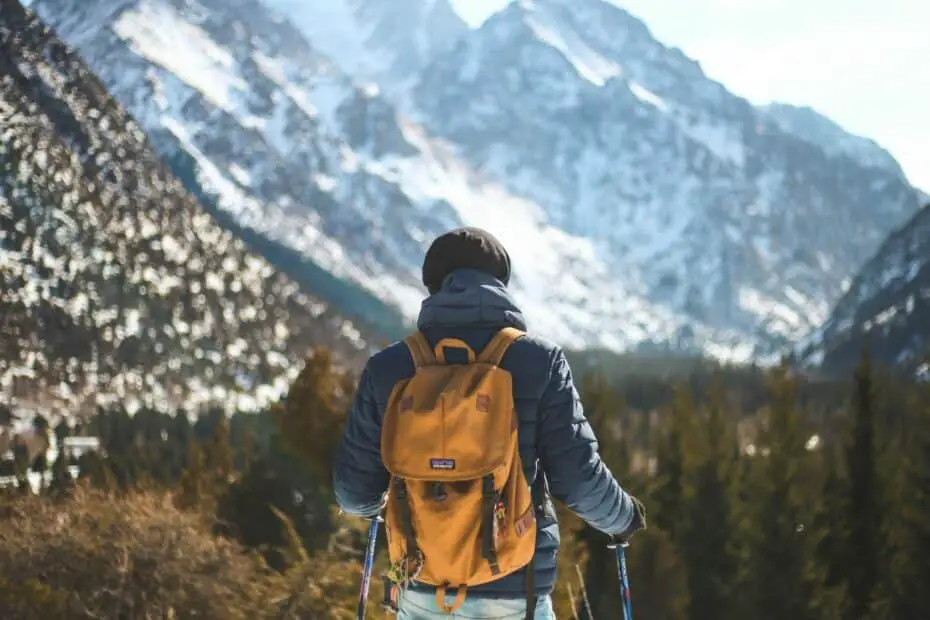Hiking can be a fun and rewarding experience, but only if you are properly prepared. One of the most important things you need to consider is what to wear. The right clothing can make all the difference in terms of staying safe/comfortable and enjoying your hike. So, how do you dress for a hike?
Hiking clothes should be durable, breathable, lightweight, functional, and comfortable. Find lightweight moisture-wicking fabrics made out of either synthetic blends or merino wool. This also applies to colder weather, but you will need to wear additional insulating and waterproof layers.
Planning the right hiking clothing can be a challenge for beginners, but it doesn’t need to be. This guide will go over everything you need to know to plan everything you need to wear on a hike.
Table Of Contents
What To Wear For A Hike: Choosing The Perfect Outfit For Hiking
Hiking has grown exponentially over the past couple years, with new hikers hitting the trail everyday. The “dress code” for hiking is a bit different than other outdoor activities. There are a few rules, you need to follow to be safe/comfortable, but the every hikers has their own unique “hiking style”.
Planning a hiking outfit isn’t difficult! You can nitpick every aspect of your hiking clothes, but it all boils down to comfort and functionality. Some people are comfortable wearing gym shorts and synthetic t-shirt, while others spend a small fortune on dedicated hiking clothes made out of technical fabrics.
There’s a no right or wrong choice when it comes to hiking clothes, but there are a few basic tips you need to follow. There are five rules you need to follow when choosing a basic hiking outfit; it needs to be functional, durable, quick-drying, lightweight, and breathable.
Once you get the basics down you will need to deal with changing temperatures, rain/snow, wind, etc. That’s where your extra layers and accessories come in. I’ll explain the basic layering principles in detail below, but lets get into a brief overview of the clothing you need for a hike.
Layering is the key to staying comfortable regardless of the weather. You need a moisture-wicking/breathable base-layer, warm insulating layer, and waterproof/windproof outer shell layer.
What To Wear Hiking (A Quick and Easy List):
- Quick-drying fabrics like synthetic technical fabrics (nylon, polyester, etc.) or merino wool: These materials work best when they’re right up against your skin. They move sweat away from your skin, which speeds up evaporation, and keeps your hiking clothes cool, dry, and comfortable.
- Never wear cotton t-shirts or denim jeans: Cotton quickly absorbs water and takes a long time to dry. You end up feeling sweaty in hot weather and cold/wet in colder temperatures.
- Choose clothing that you can move in. This should sound obvious, but you need to wear clothes that are comfortable to move in. You should be able to squat down, jump, climb, jog, scramble up a hill, etc.
- Wear comfortable/durable pants or shorts: Experts recommend long synthetic hiking pants all year long, even in the summer, to prevent scrapes, poison ivy, ticks, etc. I’m a sweaty guy so I usually wear synthetic hiking shorts when it’s over 70°F, but it’s probably not the best decision.
- Sturdy durable shoes: Wear comfortable sturdy shoes that provide support and traction on both wet and dry surfaces. You don’t need to wear waterproof hiking boots! Any pair of comfortable/durable shoes will work (I like Salomon trail runners).
- Hat and Sunglasses: A hat and sunglasses will protect your head and eyes from the sun. Your hats brim will also keep rain off your face and out of your eyes.
- Warm Jacket: I always carry a lightweight wind/water resistant jacket in my pack, but you might need a heavier insulated jacket in colder spring/fall weather.
- Rain Gear: Buy breathable well-ventilated rain gear with mesh air panels or pit zips. A poorly ventilated jacket leads to sweat and condensation, which can be worse than the rain.
1. Underwear and Socks To Wear Hiking: Merino Wool or Synthetic
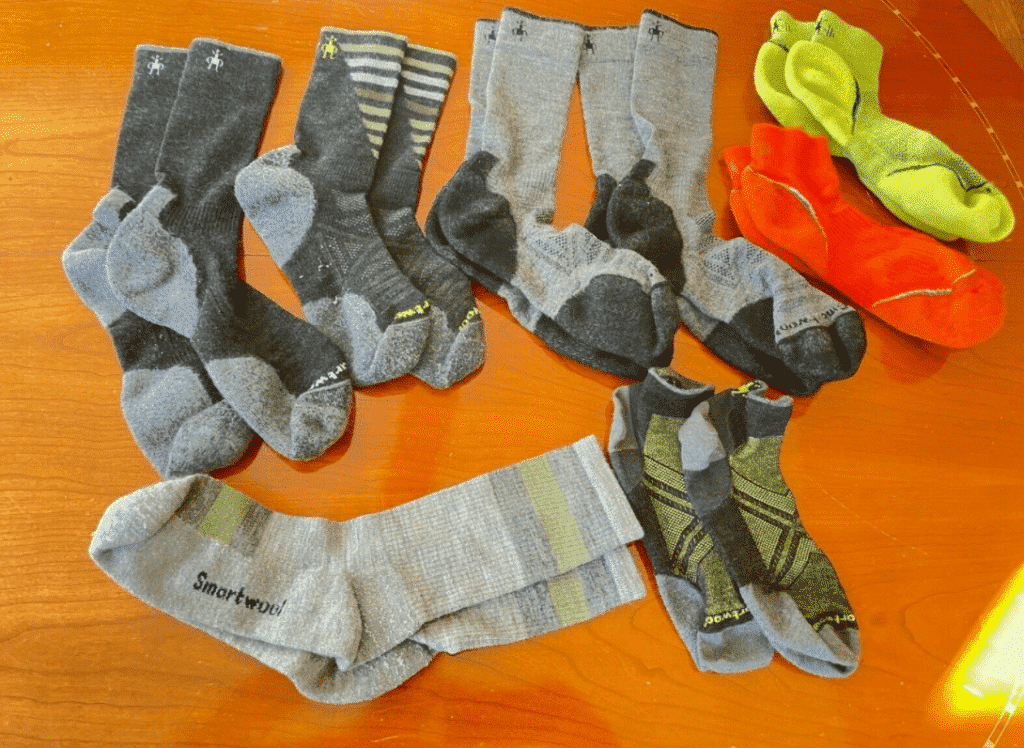
Choosing the right underwear and socks will solve 99% of chafing and blister problems. Most chafing/blister issues are the result of sweaty clothing rubbing against your skin. Eliminating moisture usually gets rid of this problem.
Leave your cotton underwear and socks at home! Cotton underwear will lead to excessive sweating and blister/chafing issues. Choose socks and underwear that are made out of a moisture-wicking fabric.
That leaves you with 2 options: merino wool and synthetic blends. Merino wool is by far the best option, but synthetic blends are cheaper. I wear wool socks 99% of the time (I like Smartwool Socks), but I usually go with synthetic long leg boxer briefs (merino wool underwear isn’t cheap).
Most people don’t think of wool as an option in warm weather, but it’s excellent at regulating body temperature. Wool keeps you cool in hot weather and warm in cold temperatures. You can wear the same pair of socks regardless of the temperature.
Merino wool dries fast and can absorb 35% of its weight in water without feeling wet. So it’s almost impossible to fully saturate wool socks in sweat. Plus wool has antimicrobial properties so your socks/underwear won’t smell after a sweaty day of hiking.
2. What Pants To Wear Hiking: Pants, Shorts, or Leggings
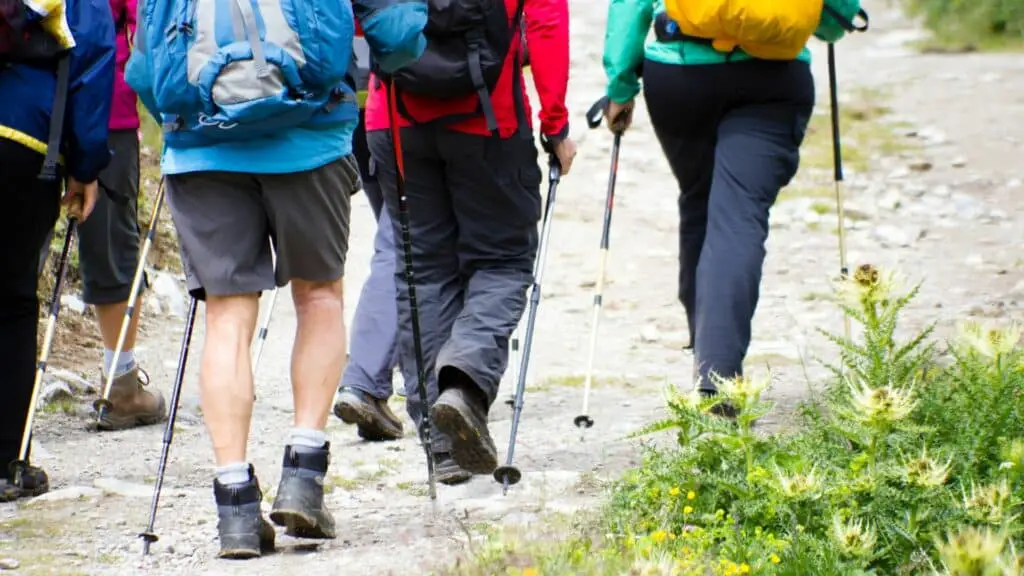
What type of pants you wear will depend on the temperature and what you’re comfortable in. Denim jeans are a terrible choice since they’re made out of cotton. They retain mositure so you’ll sweat bullets and end up with a heat rash and inner thigh chafing.
Narrow down your search by focusing on moisture-wicking technical fabrics. Any pair of quick dry pants will work, but I usually wear Columbia Hiking Pants. Just make sure they’re made out of synthetic fabric like a polyester/nylon blend.
Women can choose either hiking pants or any pair of full length leggings. My wife usually wears leggings since they’re comfortable and protect against ticks, mosquitos and other biting insects.
When it’s really hot out I’ll go against the advice of outdoor experts and wear synthetic shorts. I’m not a fan of quick-dry hiking shorts since they have lots of cargo pockets (I hate unnecessary pockets). So I usually wear a cheap pair of Izod golf shorts or fishing shorts will work.
3. Shirt To Wear Hiking: Moisture Wicking T-Shirt
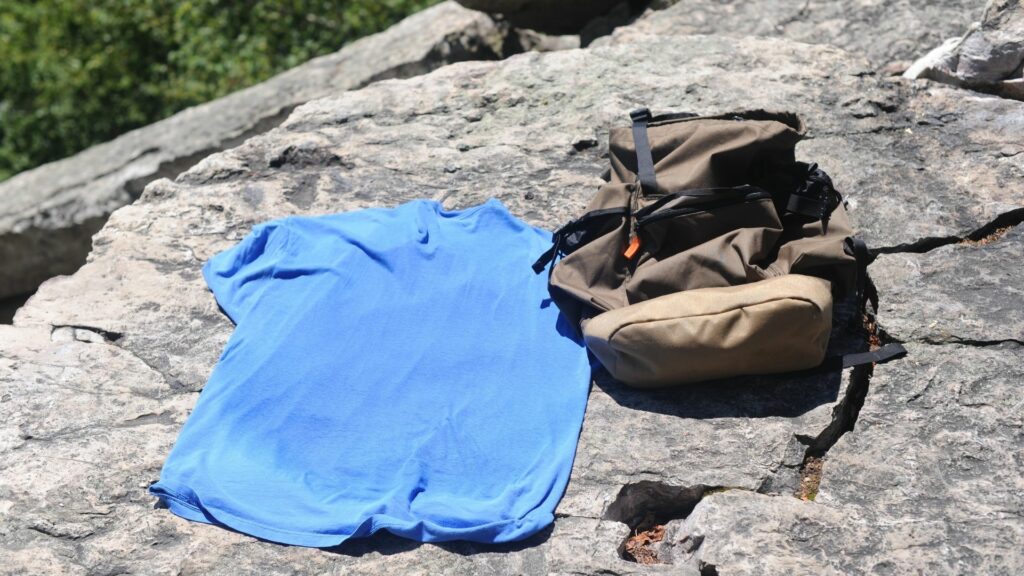
Any comfortable synthetic t-shirt is perfect for hiking (merino wool is another option). You can go with either long or short sleeves depending on the weather. I like to go with short sleeve shirts and carry a breathable water-resistant windbreaker in case I get cold. The windbreaker doubles as my rain gear unless the weather forecast looks rough.
Just keep in mind that your t-shirt will support the weight of your backpack’s shoulder straps. So an uncomfortable shirt will continuously rub against your skin. Make sure you avoid cotton and any shirt that has uncomfortable shoulder seams.
You may also want to consider SPF protective t-shirts if you’re susceptible to sunburn. I wear them all the time while I’m fishing, but I tan easily so rarely need them while hiking. It can be hard to remember sunscreen so SPF shirts can make a huge difference.
4. Hiking Shoes/Boots
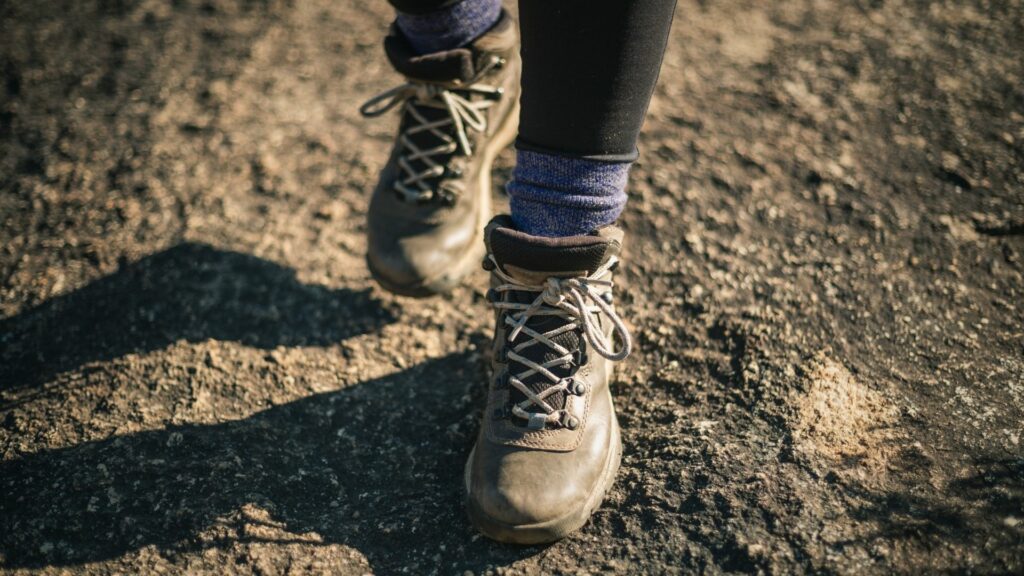
Let’s start off this section by stating a simple fact. You do not need to wear dedicated hiking shoes/boots. Any pair of comfortable running shoes or athletic shoes will be fine on 99% of trails. The only time you need real hiking shoes/boots is on technical trails with an increased risk of ankle injury.
Most people take the wrong approach when looking for hiking shoes/boots. They look for waterproof or water-resistant boots, because they don’t want to get their feet wet. That seems like a good idea until you think about sweat and exterior moisture getting trapped in the shoe.
Water-resistant hiking shoes are somewhat breathable so they’re not bad, but waterproof hiking boots are one step above torture in the summer. It doesn’t matter if you use anti-blister cream (my favorite) and wear merino wool socks. Waterproof hiking boots are a guaranteed way to get blisters!
Only wear waterproof hiking boots in cold weather! Purchase a pair of waterproof 200g insulated boots for the winter and use water-resistant shoes/boots or trail runners in the spring/fall/summer.
I prefer a less aggressive pair of hybrid trail runners (Sense Ride 4) over traditional hiking shoes/boots. They’re much lighter, breathable, and offer better traction in the mud. Trail runners aren’t just for running on trails! They can also be used for casual hiking or you can run on the road with hybrid trail runners.
Trail runners can seem strange when you first start wearing them. Most hiking shoes/boots are designed to keep out water, but trail runners take the opposite approach. They let in water, but they’re well ventilated so they dry ridiculously fast.
I can walk right through a creek and my shoes will be dry in 15-20 minutes. Just make sure you pair them with fast drying merino wool socks (my favorite).
5. Carry A Lightweight Jacket To Store In Your Pack
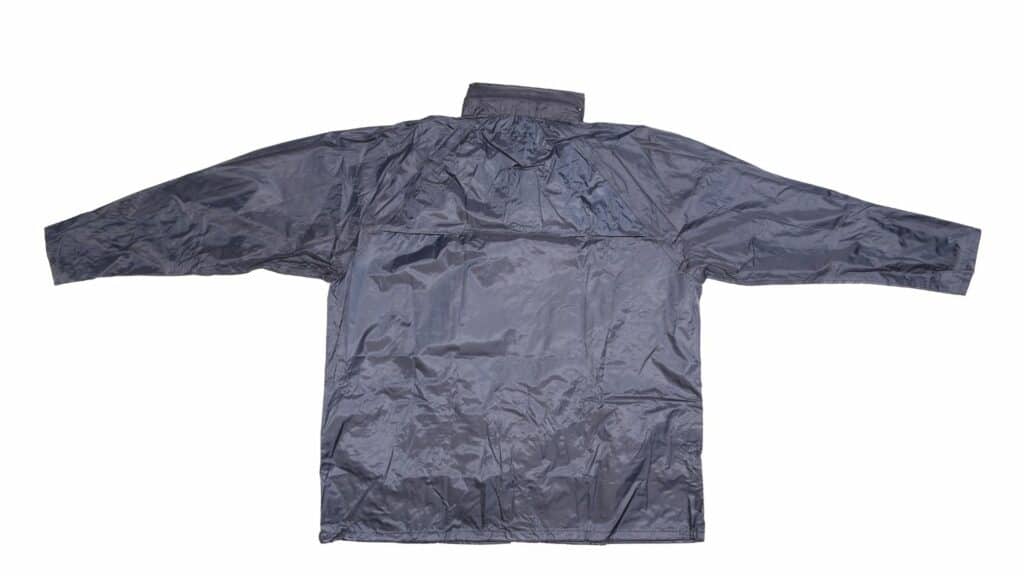
It doesn’t matter what the the weather forecast says, I always carry breathable water-resistant windbreaker in my pack. The jacket serves 2 purposes. I’ll wear it on chilly morning or when it’s windy out and use it as a makeshift raincoat if I get caught in the rain. I carry a real waterproof rain coat on longer multi-day backpacking trips, but it’s nice to have when you get caught in an unexpected storm.
6. Insulating Layer and Waterproof/Windproof Outer Shell Layer (For Cold Weather)
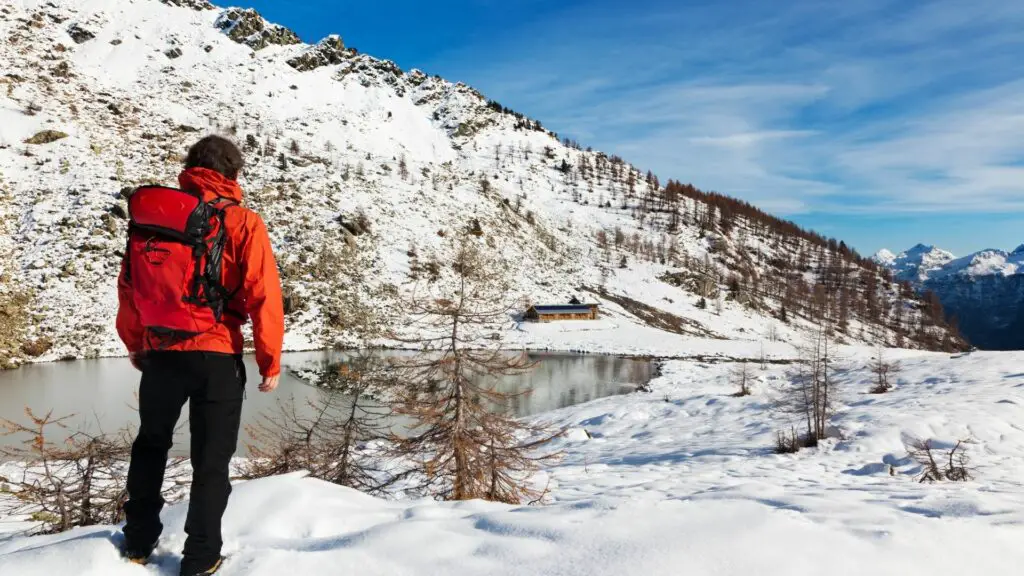
A light windbreaker is fine in the summer and warmer spring/fall days, but you might need to pack a warm insulating layer and waterproof/windproof outer shell layer. I’ll give a brief overview here since I describe insulating/shell layers in detail below.
Fleece jackets are good enough on cold spring/fall days, but you may need a warmer puffer style jacket in the winter. Fleece pullovers come in different thicknesses. Go with a lightweight fleece jacket for spring/fall and middle/heavy weight for colder weather.
Remember that you will exercising, so find a jacket that’s just a little bit chilly when you’re hanging around outside. The only time you wear the waterproof/windproof outer shell layer is when the weather turns. So make sure you’re comfortable wearing the insulating layer on its own.
Your outer shell layer needs to be breathable and 100% waterproof. It’s worth spending the extra money on a jacket with mesh ventilation channels. You don’t want to get drenched in sweat and condensation each time you wear the jacket.
7. Rain Gear (Optional Depending On Weather)
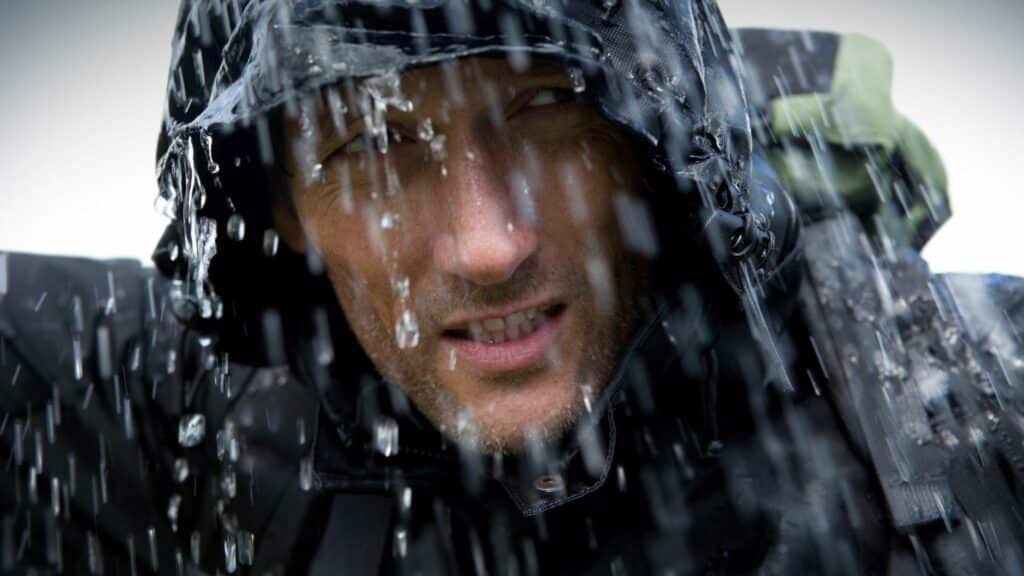
It’s probably not a smart idea, but I rarely carry my rain gear. Even when I do carry raingear, I rarely put it on. I plan my hikes around the weather and only put on rain gear when it’s absolutely necessary. It only goes on when there’s a serious downpour coming.
Remember that waterproofing works both ways! Rain gear is great at keeping out rain, but it also traps sweat. There will be a huge temperature difference between the body heat inside your rain gear and the cool air during a rainstorm (It’s a recipe for condensation).
You really need to time when you put on your rain gear. If you mess up the timing, your clothes will be soaked worse than if you left the raingear off completely. I usually let the moisture-wicking properties handle light rain and wait until moderate/heavy rain to put on waterproof gear.
Choosing raingear with ventilated panels and pit zips helps a little bit, but waterproof jackets never offer enough ventilation to completely eliminate sweat/condensation.
Check out my post explaining the purpose of rain gear pit zips for more information.
8. Head Protection: Hats, Caps, Head Scarfs, Balaclavas, and Beanies
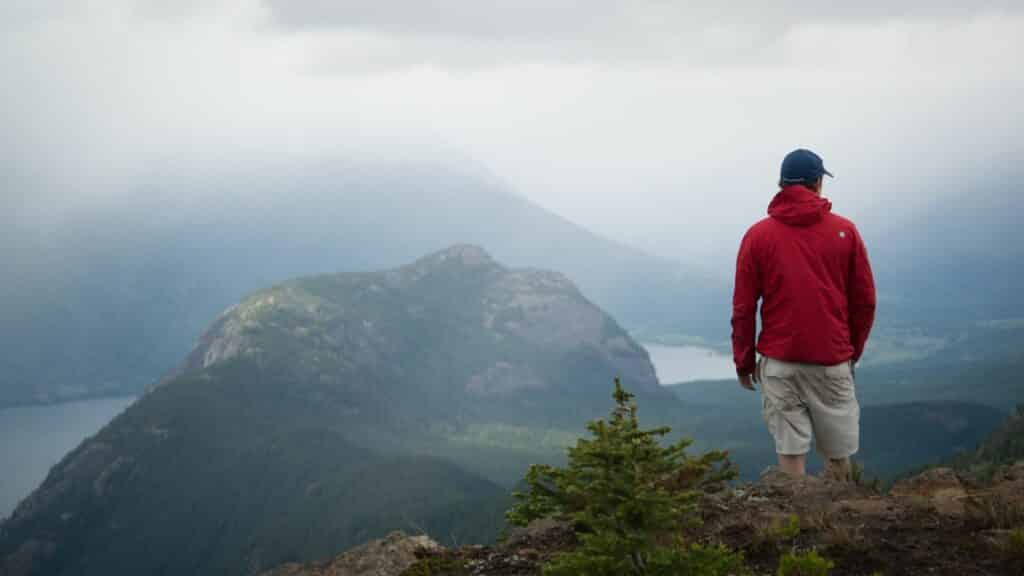
I’m not a hat guy, but my bald head fries fast hiking in the summer! Even if you don’t like hats, you should consider adding one to your hiking clothes. Hats serve five very important purposes while hiking.
They protect your head, face, and sometimes neck from the sun, keep rain/snow off your head, sweat out of your eyes, warms/cools your head depending on the season, and long brimmed hats keep the sun out of your eyes.
You have a few options to choose from; hats, caps, scarfs, balaclavas, and insulated winter caps/beanies. Pick whichever option best suits your style and the weather condition. I usually wear either a standard baseball cap or dorky sun hat in the summer. Winter requires an insulated winter cap or beanie.
9. Other Hiking Gear: Sunglasses, Trekking Poles, Hydration Packs, Watches, Gaiters, and Bug Protective Clothing
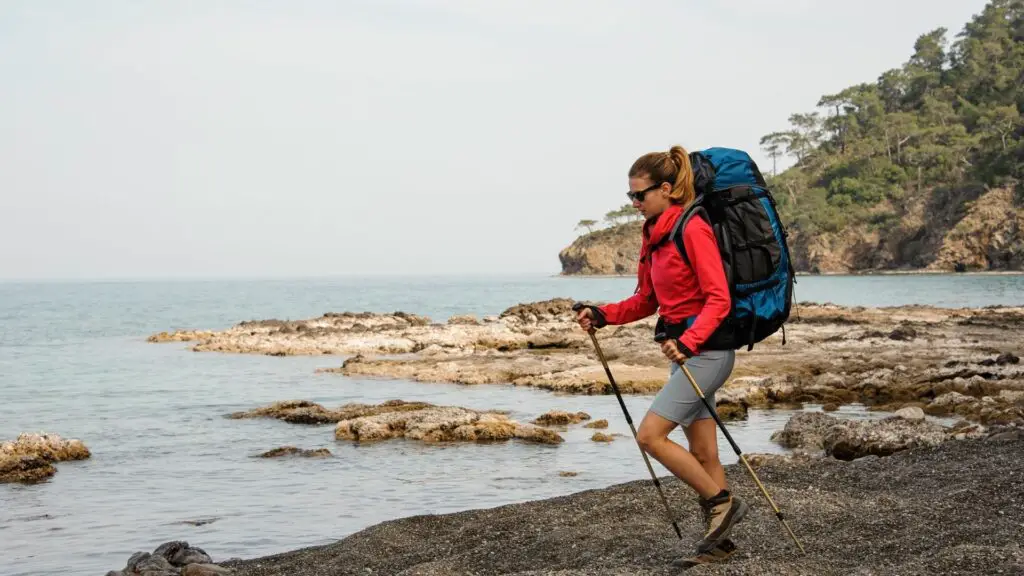
There are a wide range of random hiking accessories that you can choose from. I can’t name every accessory, but there are a few that are worth mentioning.
- Sunglasses: Sunglasses are the only item on this list that I consider a necessity. Your eyes are vulnerable to sunburn on long hikes so they can make a huge difference on sunny summer hikes. Wear a pair of brown, copper, or rose colored sunglasses to add contrast or use grey or green lenses if for a neutral color picture in full sun.
- Trekking Poles: I don’t know if trekking poles fall into the clothing category, but they’re important so I’ll include them anyway. Trekking poles serve two very important functions: they increase stability on the trail and help reduce your trail weight by about 20%. So a 200lb person with a 20lb pack using trekking poles will have 44ish pound difference in perceived trail weight. That’s like removing a 5 gallon jug of water off your back.
- Gaiters: Do yourself a favor and pick up a pair of waterproof gaiters. I originally picked up insulated gaiters to use in the winter, but now I carry a lightweight set to use in the summer. They keep mud and water off your pants/socks and make a huge difference on long hikes. I didn’t realize how terrible it is to hike in mud crusted pants/socks until I started using gaiters.
- Hiking watches: There are two approaches you can take with hiking watches. You can either go with a basic watch to keep track of time or use a smart watch to track your hike. Fitbits are an affordable to get a rough idea of hiking milage, but you can also find GPS enabled hiking watches that link up with hiking trail apps. My wife bought me a Garmin Fenix 7s Solar Watch for Christmas and you can bring up trail maps on the display.
- Hydration Packs: You will need to find a way to carry water on your hikes. I carry a hydration pack compatible backpack with an Sawyer Mini Inline Filter on the hydration tube, but you can also carry a hiking fanny pack with a built in water bottle holder. Fanny packs are great for short 1-2 hour hikes, but I prefer a 20liter pack with a 2 liter hydration bladder on longer day hikes.
- Bug Protective Clothing: Wearing long pants/shirts will protect most of your body from ticks and biting insects, but consider bug protective clothing if you’re hiking in places known for mosquitos, no-see-ums, black flies, etc. (swamps, dark forests, brushy woodlands). Look for bug-net clothing and clothes with built-in insect repellent. You can also spray your clothing with permethrin (my favorite) or soak them in 10% permethrin (Durvet Permethrin) which lasts 6 weeks.
Does Hiking Clothes Color Matter?
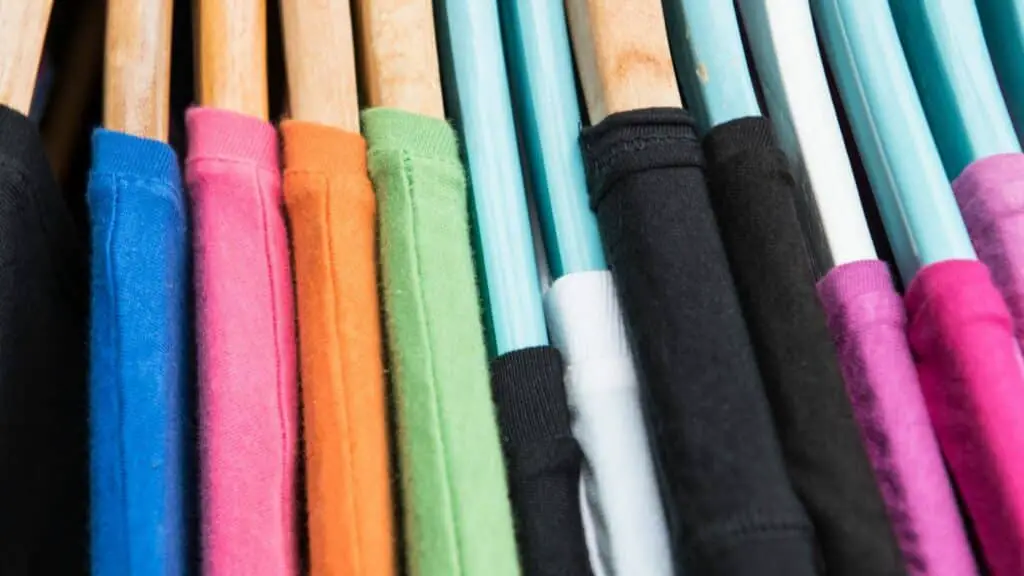
There are a few different trains of thought when it comes to the color of your hiking clothes. People seem to fall into 3 camps: plan hiking clothes around the weather, wear neutral colors to blend in with nature, or where bright attention-grabbing colors in case of an emergency. All of these options make sense, so lets take a closer look.
- Colors To Regulate Temperature: Light colors easily reflect sunlight keeping you cooler and dark colored clothing traps the heat from the sun making you feel hotter. Whether or not that makes a difference depends on the temperature. I’ve noticed a difference on 80°F+ days, but the effects aren’t as noticeable in moderate temperatures.
- Attention Grabbing Colors: Wearing bright attention grabbing colors will make you easy to spot in an emergency. This could mean the difference between rescue and death if you ever get lost in the woods. The chances of that happening are unlikely, but it does happen. With that being said, I always wear bright clothing during gun season. I wear a blaze orange hat/shirt, because I would like to avoid getting shot at.
- Neutral Colors To Blend In: Most hiking gear falls into the neutral color palette so you blend into your surroundings. Logic dictates that you’re more likely to run into animals wearing neutral colors, but it won’t make much of a difference. Animals will smell and hear you before you get close to them on the trail.
What To Wear Hiking For Each Season
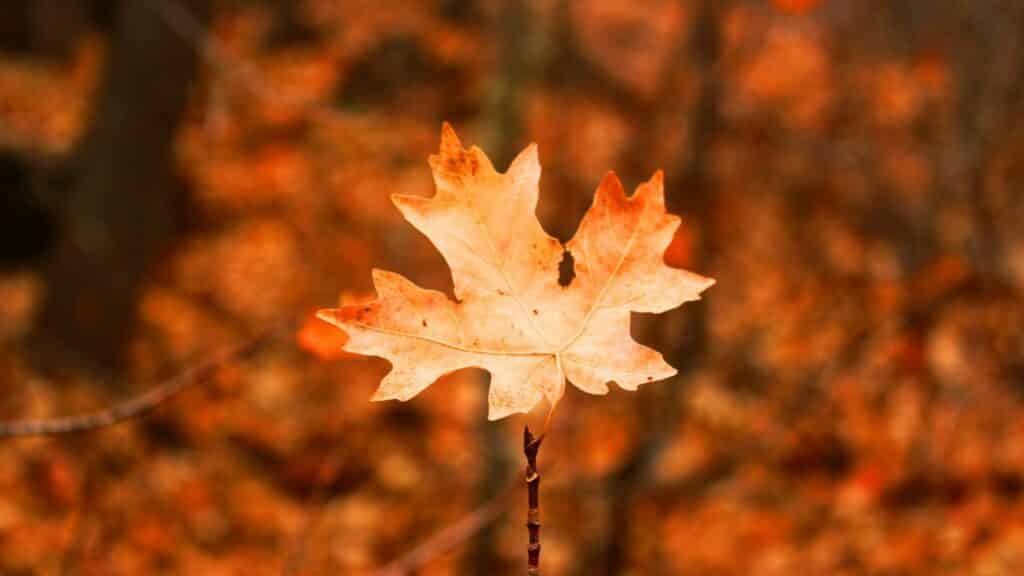
Check the weather before heading out on a hike. This should give you a good idea of the hiking clothes you need for the day. Play around with merino wool and synthetic base layers until you find hiking clothes that work for you. I also recommend carrying an extra weatherproof jacket in case there’s an unexpected temperature drop.
- Summer: T-Shirt, shorts/pants, merino wool or synthetic socks/underwear, and water-resistant windbreaker in your pack.
- Spring/Fall: Wear long-sleeve synthetic or wool shirt, windbreaker, light fleece pullover, shorts/pants. You might need to wear summer or winter clothing if there’s a change in warmer/colder weather.
- Winter: Waterproof hiking shoes/boots, merino wool socks, moisture-wicking base layer (merino wool long johns), long sleeve shirt, warm insulating layer (down or synthetic), waterproof and windproof outer shell, and rain gear.
Check out my post on winter camping clothing!
A Quick Note: Fleece is water-resistant, but it’s terrible at blocking wind. It will force you to wear a wind-resistant outer shell, which can get hot on strenuous hikes.
Finding The Right Fabric and Insulation To Layer Hiking Clothes

- Merino Wool: Merino wool is the king of base layers (no longer itchy), since it’s warm in cold weather and cool in the heat. Wool is soft, breathable, moisture-wicking (dries fast), comfortable when wet, prevents blisters/chafing, and has antimicrobial properties so it won’t smell. Wool can absorb 35% of its weight in water without feeling wet making it by far the best choice as a base layer.
- Synthetic Fabrics (Polyester and Nylon): Most synthetic technical fabrics have a fancy trademarked name (like Coolmax, DriFit, etc), but it’s just a blend of polyester and nylon. Synthetic fabrics are great in the summer, but they don’t provide as much insulation as wool when wet. They can also lead to chafing and blisters on long hikes, so you need to be careful.
- Fleece: Fleece jackets are made out of polyester which makes it a breathable fast drying, water-resistant insulation layer. The only downside, is that fleece is terrible when it comes to wind.
- Polyester/Nylon Hard Shell Jackets: As you may have noticed, most outdoor gear is made out of nylon or polyester since it’s breathable while resisting moisture. Outer shells take that moisture resistance further by applying a specialized waterproof coating to protect you from the wind and rain.
- Cotton: Cotton is notoriously terrible at a wicking moisture, but there are times when you can wear it. You can get by hiking in cotton clothing in mild weather, but synthetics or wool is a much better option. There’s a reason why so many hikers live by the saying “Cotton Kills”. Cotton traps water on your skin which increases your risk of hypothermia in cold weather.
- Silk: Silk is one of those fabrics that you either love or hate. Personally, I don’t think it’s durable enough for hiking, but the temperature-regulation and moisture wicking properties make it a reasonable choice.
How To Layer Hiking Clothes: Base Layer, Insulating Layer and Shell Layer
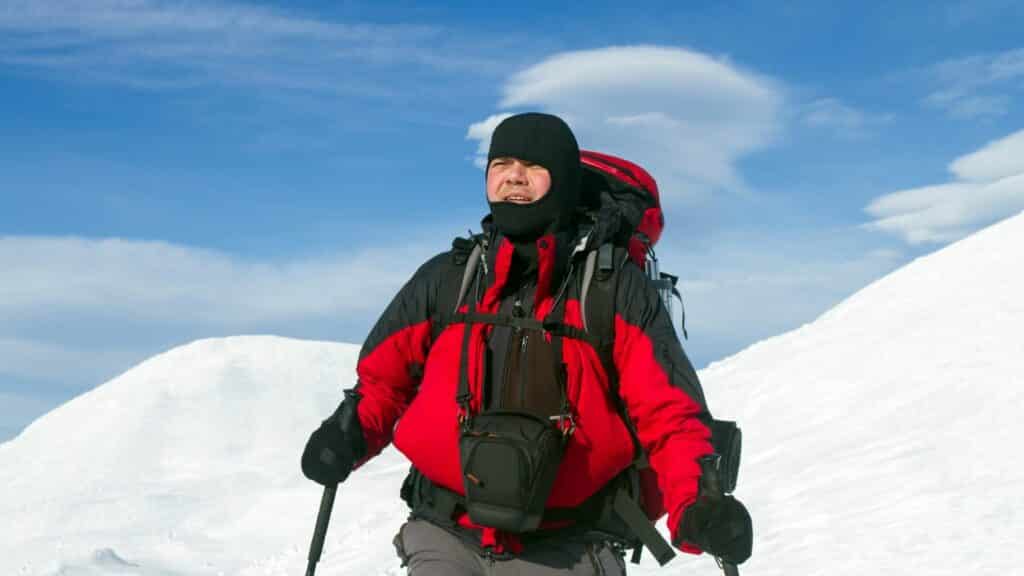
To understand how to layer hiking clothes, you need to know the function of each layer. Whether or not you need to wear each layer depends on the season. You will only need a light base layer in the summer, but you should carry a light outer shell layer just in case it gets windy or rains.
- Base Layer (underwear layer): wicks sweat away from your body. Choose synthetic fabrics or merino wool.
- Middle Layer (Insulating Layer): Protects you from the cold by retaining body heat.
- Outer Layer (Shell Layer): Shields you from the elements, wind, snow, rain, sleet, etc.
Moisture-Wicking Breathable Base Layer (Merino Wool or Synthetic)
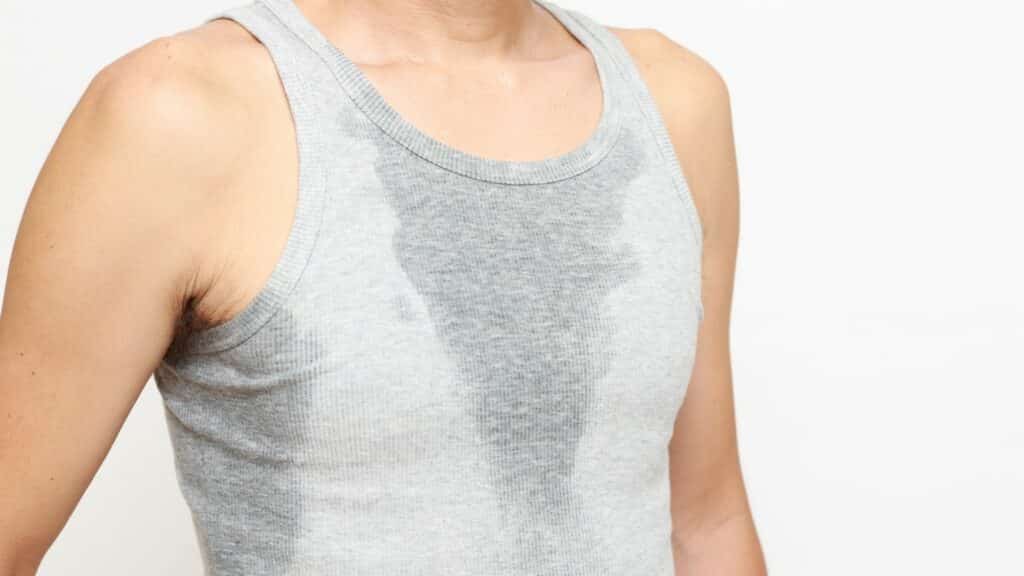
You need to choose a moisture wicking fabrics to use as a base layer. There are two fabric choices you can use as a base layer: synthetic technical fabrics and merino wool. Synthetic fabrics are better than cotton, but merino wool is a far better option!
What does moisture wicking fabric mean?
Merino wool can absorb 35% of its weight in water without feeling wet, retains insulating properties when wet, keeps you warm in cold weather, cool in the heat, and it’s by far the best option when it comes to blister/chafing prevention.
The price is the only downside to merino wool base layers. You will get the biggest bang for your buck by purchasing merino wool socks (I like Smartwool Socks) and underwear (Smartwool Underwear). I buy all of my long sleeve merino wool shirts at Goodwill for like $8. Merino.tech and Meriwool Base Layers are a budget option if you don’t want to spend the extra money on Smartwool base layers.
Some people can get away with synethic base layers, but I always wear merino wool socks and underwear. I’m susceptible to blisters and chafing so I don’t mess around with my socks/underwear. You can probably save some money with synthetic long sleeve shirts and long johns in colder weather.
Warm Insulating Layer: Fleece Or Puffy Jackets (Down or Synthetic)
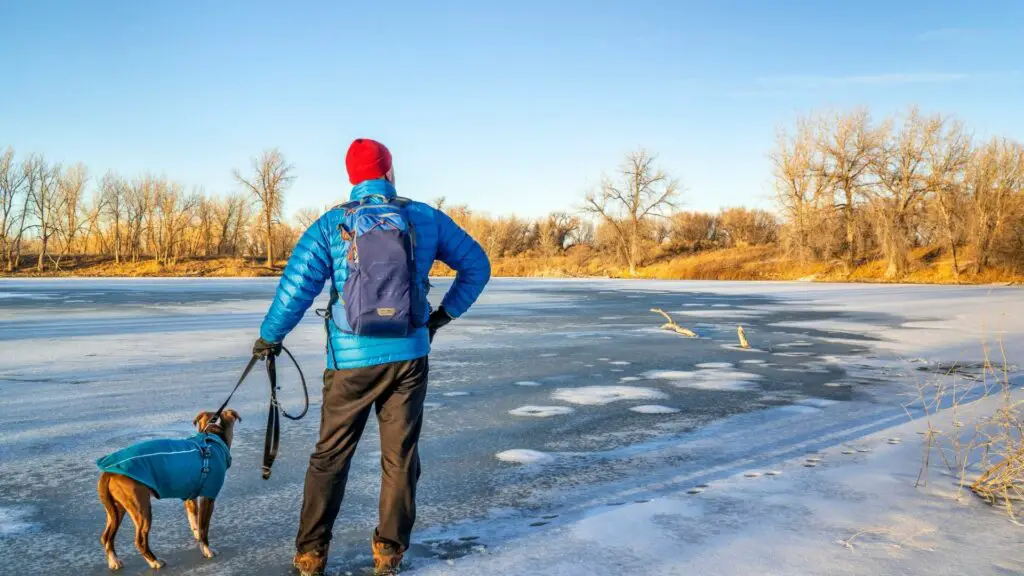
Your mid-layer (aka Insulating layer) is the layer that provides 90% of the warmth. I like to carry 2 insulating layers: A lightweight fleece jacket and warmer lightweight puffy jacket that I keep in my day pack. I wear the fleece jacket most of the time and only throw on the puffer jacket when the temperature drops or wind picks up (fleece is bad in wind).
- Fleece Jacket: Wear your fleece jacket on colder days as your primary insulating layer. Fleece jackets range from lightweight summer coats to heavyweight winter coats so choose your jacket based on the temperature.
- Puffer Insulated Jacket or Vest: You will only need to wear the puffer style jacket when it gets really cold. Down insulation is lightweight and packs well, but it loses most of its warmth when it gets wet. Synthetic insulation is little bit heavier, but it’s water-resistant making it a better bet for most people.
Down vs Synthetic Insulation
Choose between down or synthetic insulation for your insulating layer. There’s really no right or wrong answer when it comes to your insulating layer. It all depends on your budget and whether you’re willing to carry the extra weight of a synthetic jacket.
Most people think down insulation is warmer than synthetic, but that’s only partially true. If there’s an equal amount of down/synthetic insulation in the jacket the down jacket will usually be warmer. Add an extra 1/2 lb of synthetic insulation and it might tip the scales in favor of the synthetic jacket.
You also need to factor in Down Fill Power (higher fill power is warmer), water absorption, and loft. Down jackets lose most of the insulating properties when wet and can get damaged through regular wash cycles. Synthetic insulation is far better at retaining loft and warmth when wet. I still prefer down, but make sure you pair it with a waterproof outer shell-layer if you’re using down as an insulating layer.
Fleece jackets can also be used as an insulation layer, but it wont’ protect you against wind. Pair a fleece jacket with a lightweight windbreaker if you plan on using it as an insulating layer.
Waterproof and Windproof Outer Shell Layer (Choose Technical Fabrics)
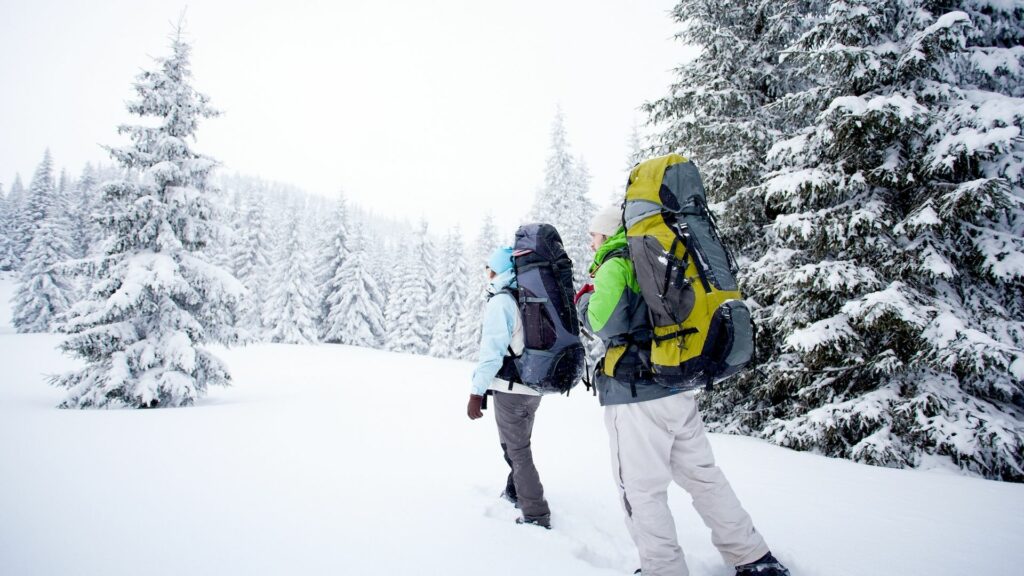
Your outer shell layer is the last line of defense to protect you from the elements; wind, snow, rain, sleet, etc. The outer shell needs to be windproof/waterproof and breathable. Most outer shells prioritize waterproofing/windproofing over breathability, which can lead to excessive sweat and condensation. You can also buy coated non-breathable outer shells, but those feel like you’re wearing a poncho in a sauna.
I recommend leaving your outer shell layer in your pack until you actually need it. Spend most of your day hiking in the base and insulating layer and only put on the shell layer when the weather turns. This will provide protection from the elements when you need it without leaving you sweaty and miserable.
Bug Protection
Don’t ignore bugs when planning out your hiking clothes. There are two primary concerns you will need to consider: biting insects (mosquitos, no-see-ums, black flies, etc) and ticks.
Your approach will vary depending on where you hike, but you should consider wearing long sleeves, long pants, and clothes with built-in insect repellents. Wearing bug-net clothing is another option, but it’s overkill in most situations.
